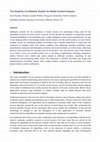Papers by Thomas Lansdall-welfare
2016 IEEE 16th International Conference on Data Mining Workshops (ICDMW), 2016
Lecture Notes in Computer Science, 2016
Proceedings of the 24th International Conference on World Wide Web - WWW '15 Companion, 2015
2016 IEEE 16th International Conference on Data Mining Workshops (ICDMW), 2016
2016 IEEE 16th International Conference on Data Mining Workshops (ICDMW), 2016

Proceedings of the National Academy of Sciences, 2017
Previous studies have shown that it is possible to detect macroscopic patterns of cultural change... more Previous studies have shown that it is possible to detect macroscopic patterns of cultural change over periods of centuries by analyzing large textual time series, specifically digitized books. This method promises to empower scholars with a quantitative and data-driven tool to study culture and society, but its power has been limited by the use of data from books and simple analytics based essentially on word counts. This study addresses these problems by assembling a vast corpus of regional newspapers from the United Kingdom, incorporating very fine-grained geographical and temporal information that is not available for books. The corpus spans 150 years and is formed by millions of articles, representing 14% of all British regional outlets of the period. Simple content analysis of this corpus allowed us to detect specific events, like wars, epidemics, coronations, or conclaves, with high accuracy, whereas the use of more refined techniques from artificial intelligence enabled us to move beyond counting words by detecting references to named entities. These techniques allowed us to observe both a systematic underrepresentation and a steady increase of women in the news during the 20th century and the change of geographic focus for various concepts. We also estimate the dates when electricity overtook steam and trains overtook horses as a means of transportation, both around the year 1900, along with observing other cultural transitions. We believe that these data-driven approaches can complement the traditional method of close reading in detecting trends of continuity and change in historical corpora.

PLOS ONE, 2016
We address the problem of observing periodic changes in the behaviour of a large population, by a... more We address the problem of observing periodic changes in the behaviour of a large population, by analysing the daily contents of newspapers published in the United States and United Kingdom from 1836 to 1922. This is done by analysing the daily time series of the relative frequency of the 25K most frequent words for each country, resulting in the study of 50K time series for 31,755 days. Behaviours that are found to be strongly periodic include seasonal activities, such as hunting and harvesting. A strong connection with natural cycles is found, with a pronounced presence of fruits, vegetables, flowers and game. Periodicities dictated by religious or civil calendars are also detected and show a different wave-form than those provoked by weather. States that can be revealed include the presence of infectious disease, with clear annual peaks for fever, pneumonia and diarrhoea. Overall, 2% of the words are found to be strongly periodic, and the period most frequently found is 365 days. Comparisons between UK and US, and between modern and historical news, reveal how the fundamental cycles of life are shaped by the seasons, but also how this effect has been reduced in modern times.
Proceedings of the 24th International Conference on World Wide Web - WWW '15 Companion, 2015
ABSTRACT

PloS one, 2016
Feminist news media researchers have long contended that masculine news values shape journalists&... more Feminist news media researchers have long contended that masculine news values shape journalists' quotidian decisions about what is newsworthy. As a result, it is argued, topics and issues traditionally regarded as primarily of interest and relevance to women are routinely marginalised in the news, while men's views and voices are given privileged space. When women do show up in the news, it is often as "eye candy," thus reinforcing women's value as sources of visual pleasure rather than residing in the content of their views. To date, evidence to support such claims has tended to be based on small-scale, manual analyses of news content. In this article, we report on findings from our large-scale, data-driven study of gender representation in online English language news media. We analysed both words and images so as to give a broader picture of how gender is represented in online news. The corpus of news content examined consists of 2,353,652 articles collecte...

Intelligent systems for the annotation of media content are increasingly being used for the autom... more Intelligent systems for the annotation of media content are increasingly being used for the automation of parts of social science research. In this domain the problem of integrating various Artificial Intelligence (AI) algorithms into a single intelligent system arises spontaneously. As part of our ongoing effort in automating media content analysis for the social sciences, we have built a modular system by combining multiple AI modules into a flexible framework in which they can cooperate in complex tasks. Our system combines data gathering, machine translation, topic classification, extraction and annotation of entities and social networks, as well as many other tasks that have been perfected over the past years of AI research. Over the last few years, it has allowed us to realise a series of scientific studies over a vast range of applications including comparative studies between news outlets and media content in different countries, modelling of user preferences, and monitoring public mood. The framework is flexible and allows the design and implementation of modular agents, where simple modules cooperate in the annotation of a large dataset without central coordination.
Springer Proceedings in Mathematics & Statistics, 2012

Proceedings of the 21st international conference companion on World Wide Web - WWW '12 Companion, 2012
Large scale analysis of social media content allows for real time discovery of macro-scale patter... more Large scale analysis of social media content allows for real time discovery of macro-scale patterns in public opinion and sentiment. In this paper we analyse a collection of 484 million tweets generated by more than 9.8 million users from the United Kingdom over the past 31 months, a period marked by economic downturn and some social tensions. Our findings, besides corroborating our choice of method for the detection of public mood, also present intriguing patterns that can be explained in terms of events and social changes. On the one hand, the time series we obtain show that periodic events such as Christmas and Halloween evoke similar mood patterns every year. On the other hand, we see that a significant increase in negative mood indicators coincide with the announcement of the cuts to public spending by the government, and that this effect is still lasting. We also detect events such as the riots of summer 2011, as well as a possible calming effect coinciding with the run up to the royal wedding.

Social Media offer a vast amount of geo-located and time-stamped textual content directly generat... more Social Media offer a vast amount of geo-located and time-stamped textual content directly generated by people. This information can be analysed to obtain insights about the general state of a large population of users and to address scientific questions from a diversity of disciplines. In this work, we estimate temporal patterns of mood variation through the use of emotionally loaded words contained in Twitter messages, possibly reflecting underlying circadian and seasonal rhythms in the mood of the users. We present a method for computing mood scores from text using affective word taxonomies, and apply it to millions of tweets collected in the United Kingdom during the seasons of summer and winter. Our analysis results in the detection of strong and statistically significant circadian patterns for all the investigated mood types. Seasonal variation does not seem to register any important divergence in the signals, but a periodic oscillation within a 24-hour period is identified for each mood type. The main common characteristic for all emotions is their mid-morning peak, however their mood score patterns differ in the evenings.
We present a web tool that allows users to explore news stories concerning the 2012 US Presidenti... more We present a web tool that allows users to explore news stories concerning the 2012 US Presidential Elections via an interactive interface. The tool is based on concepts of "narrative analysis", where the key actors of a narration are identified, along with their relations, in what are sometimes called "semantic triplets" (one example of a triplet of this kind is "Romney Criticised Obama"). The network of actors and their relations can be mined for insights about the structure of the narration, including the identification of the key players, of the network of political support of each of them, a representation of the similarity of their political positions, and other information concerning their role in the media narration of events. The interactive interface allows the users to retrieve news report supporting the relations of interest.
Abstract The efficient annotation of documents in vast corpora calls for scalable methods of text... more Abstract The efficient annotation of documents in vast corpora calls for scalable methods of text classification. Representing the documents in the form of graph vertices, rather than in the form of vectors in a bag of words space, allows for the necessary information to be pre-...
Digital Journalism, 2012
News content analysis is usually preceded by a labour-intensive coding phase, where experts extra... more News content analysis is usually preceded by a labour-intensive coding phase, where experts extract key information from news items. The cost of this phase imposes limitations on the sample sizes that can be processed, and therefore to the kind of questions that can be addressed. In this paper we describe an approach that incorporates text-analysis technologies for the automation of some of these tasks, enabling us to analyse data sets that are many orders of magnitude larger than those normally used. The patterns detected by ...











Uploads
Papers by Thomas Lansdall-welfare